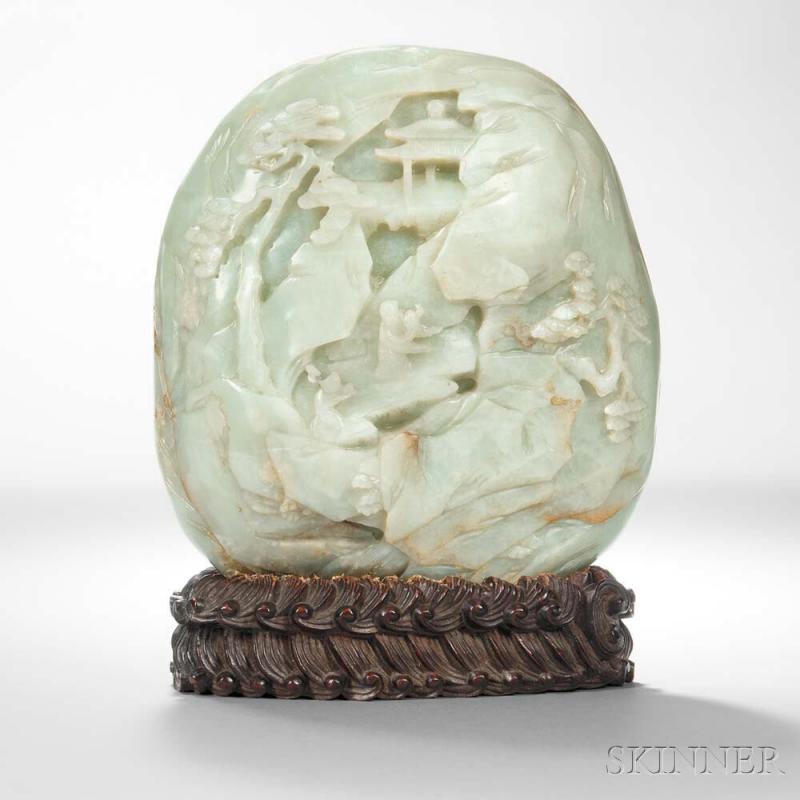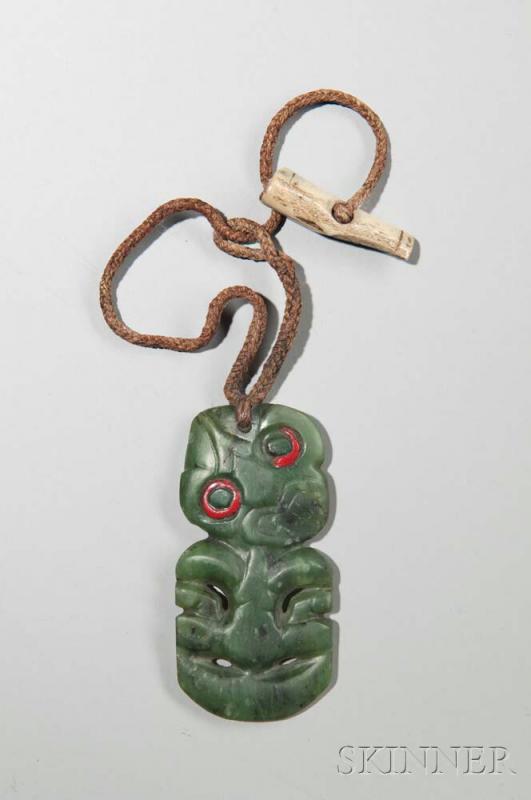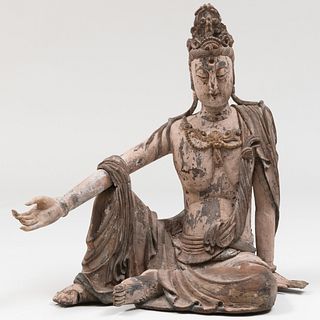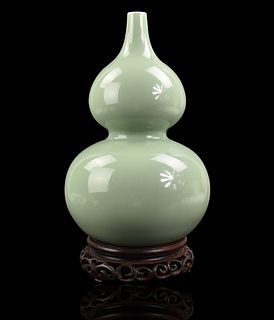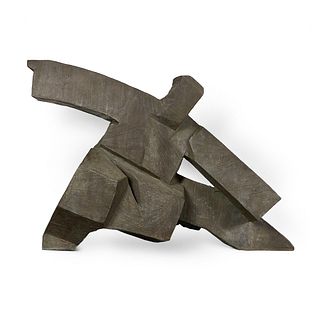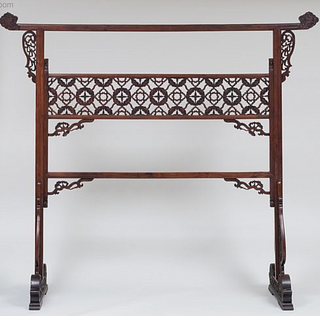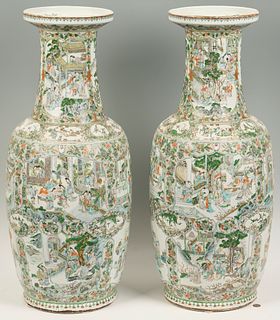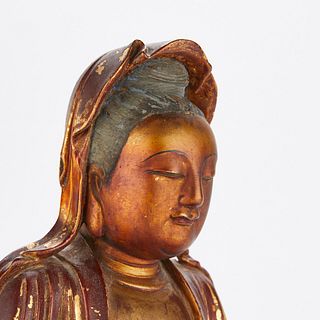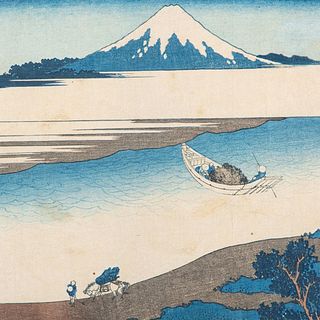The Jewel of Heaven for Centuries: Jade Stone Its Meaning and Benefits
Mesmerized by the magnificence of the jade stone, the Chinese Qianlong Emperor collected the most exquisite and exclusive assortment of jade objects of the Qing dynasty period. Legend tells that the emperor composed more than 800 songs and verses dedicated to his jadeite treasures. Scribes carved this literature onto jade artifacts, as was the practice with many Chinese rulers. Qianlong’s obsession with jade sparked a passion for jade jewelry around the world. After raw jade imports from Burma increased, this precious stone became a cultural passion among Chinese royal and noble families. A gigantic jade sculpture carved in the 18th century CE is a classic example of how the jade stone captured the Chinese imagination. Yu the Great Taming the Waters, which depicts a Qing landscape, required over seven years of work and illustrates China’s romance with jade.
Lot 235, A Jade Pendant Height 2 1/2 inches. Sold at Hindman in 2015 for $20,000
According to a Chinese saying, ‘you can put a price on gold, but jade is priceless.’ No wonder the Chinese character for jade bears a stark resemblance to the character referring to the emperor. The similarity between these two characters underscores the intrinsic association between this stone and the Chinese nobility. Regarded as a “jewel of heaven” and a symbol of purity, royal families came to associate the stone with aesthetics and status.
Being an expert people often ask me what is Jade Stone? What are the meaning and benefits of Jade Stone? Well Jade Stone Popularly known as a stone of good luck and prosperity, “jade” actually includes two different minerals: jadeite and nephrite. While they may seem similar in toughness and appearance, the two are different in their mineral compositions. Nephrite is a magnesium-rich amphibole with pale and opaque hues. Its color depends on the levels of iron and other elements in the stone. On the other hand, jadeite is a pyroxene mineral that is rich in aluminum. Jadeite often has deep shades and lustrous looks. While nephrite can be found in China, Taiwan, Russia, Australia, New Zealand, the United States, and Canada, jadeite is mostly found in Myanmar (formerly Burma). The Khotan region in Central Asia is also home to jade stone.
Ancient Chinese artisans shaped jade stone using a cord and sand since it was impossible to cut with metal tools. Working with ancient tools required immense effort, and this made jade products even more valuable. Early artists carved only linear designs due to jade’s toughness. More sophisticated designs emerged over time.
Lot 202, Jade Boulder 玉山擺件 - China, 18th century. Sold at Skinner in 2017 for $30,000
The Crowning Glory of Chinese Sculpture
China’s association with jade traces back to 2070 BCE. During the Neolithic period, humans carved rectangular jade tablets resembling weapons and tools. Jade’s green color was the much-desired shade for centuries. Ceramicists of the 8th century BCE mimicked the jade stone’s green color in their wares. The pure white jade stone from Central Asia was especially popular during the 1st century BCE, followed by its proliferation in the Han dynasty (206 BCE - 220 CE).
The Hongshan and Liangzhu cultures used jade for various ritualistic and sacrificial objects. As families considered jade to be an eternal stone, they commonly buried jade objects with deceased individuals. Survivors often used jade cicadas to preserve the decomposing body. An archeological excavation once unearthed a fascinating 113 BCE tomb at Mancheng, Beijing. Researchers found a royal couple covered in suits made with over 1,000 small squares of jade fused with gold and silver wiring.
During the Shang dynasty (1766 - 1111 BCE), artisans carved objects such as chimes, burial seals, abstract meanders, spirals, and hooks using jade stone. Ritual cups called bi, later known as zong/cong, were disc-shaped objects. They often contained a cutout in the center and notches on the outer edge. Artists made bi during the Shang and Zhou dynasties (1600 - 221 BCE) and often placed them on the chest or the waist of the dead. Archaeologists also found crescent-shaped decorative plaques called Huang. Tomb excavations frequently reveal jade jewelry, miniature sculptures of monsters and humans, halberd blades, bull masks, and miniature tools.
In the early days, Chinese sculptors used jade in its nephrite form. Many cultures particularly valued nephrite jade for its durability and rarity. Confucianism also ascribed a sense of morality and purity to the jade stone. Carvers used jade for various ritualistic articles and decorative objects, ranging from desk ornaments to jewelry. Jadeite became popular much later. Qianlong’s obsession with the stone in the 18th century prompted higher jadeite imports from Burma.
Many ancient Chinese poets drew analogies between jade and the voices of their loved ones. This is because the stone has certain intrinsic musical properties. Jade does not break when hit with a heavy object. Instead, it rings like a bell. Many other precious elements such as diamond and quartz simply shatter or crack when struck. As a result, craftsmen often used jade to create instruments such as gongs and chimes.
Lot 67, Maori Jade Ornament, "hei tiki," c. 19th century, with original cord and bone toggle. Sold at Skinner in 2017 for $21,250
Māori and the Mystique of Jade Hei-Tiki
The Māori, the indigenous Polynesians of New Zealand, have a profoundly supernatural and mystical connection to jade. The Māori strongly believe that hei-tiki ornamental Jade pendants guide the wellbeing of their families and hence carefully preserve these spiritual pieces. The Māori carved weapons, tools, and jade jewelry even in ancient times.
The Māori also practice a ritualistic hunt associated with jade hei-tiki. Traditionally, a Māori family engages a tohunga or wizard to locate raw jade when they wish to make a hei-tiki. The family follows the hunt led by the tohunga. He goes into a trance to communicate with the ancestral spirits and find the jade stone. Once the tohunga finds it, the Māori family names the jade after the spirit that helped locate it. Equally mystical is the burial and retrieval of the pendant. After the death of loved ones, especially important clan members such as the chieftain, Māori families bury the hei-tiki with them. A close male family member later retrieves the piece.
Ancient Meso-American and Egyptian cultures also held jade in high esteem. It was once a common practice to place jade in the mouths of the departed in these cultures. Legend has it that the Aztecs valued jade far above gold.
Lot 275, Nephrite Yellow Jade Covered Vase 黄色和田玉花瓶 - Sold at Skinner in 2017 for $48,750
Jade Stone Benefits For Body and Mind
Physical healing, mental strength, and emotional wellbeing are some of the popular benefits of jade stone. Jade helps cleanse toxins from organs and balance fluids in the spleen, bladder, and kidneys. It also has cooling benefits that help fight infections and regulate body temperature. In ancient China, physicians sometimes mixed the jade powder with water as a panacea for body ailments and longevity. The stone is also known to improve one’s sex drive and can be beneficial for those dealing with sexual problems.
On a mental and emotional level, jade has other benefits. It is believed to keep negative thoughts at bay and harmonizes the heart chakra. Jade is known to instill courage, confidence, and self-esteem while clearing thought processes and calming emotions. Different shades of jade are associated with varied physical, mental, and emotional benefits. For example, brilliant blue jade is thought to inspire reflection and peace while serene lavender jade exudes a sense of spirituality.
In the last decade, there has been a steady rise in the popularity of jadeite among non-Asian buyers. If record-breaking auction sales around the world are anything to go by, the charm of jade still intrigues and inspires.
Read: Why Jade Has Been a Symbol of Good Fortune for 3,000 Years
____________________________________
Don't have a Bidsquare account? Sign up here!
Be in the know about upcoming auctions and exciting post-sale results by following us on Facebook and Instagram.
- Artist Spotlight: David Gerstein, Sculptural Pop in Bold Color & Motion
- The History of Rolex Watches: Innovation, Precision, and Enduring Prestige
- Preview the December Doyle+Design Auction: A Celebration of Modern & Contemporary Mastery
- Billings Winter Design 2025: A Celebration of Modern Mastery Across Eras
- The Ultimate Holiday Gift Guide: Luxe Finds From Bidsquare’s Finest Auctions
- Fine & Antique Jewelry Sale: A Curated Journey Through Craftsmanship & Design
- Upcoming Auction Spotlight: Doyle’s Fine Art: 19th Century & Early Modernism
- Entertain with Style This Holiday Season: Highlights from Doyle’s December 8 Auction
- Six Standout Lots from Newel’s Fine Jewelry, Timepieces & Luxury Handbags Sale
- Artist Spotlight: Roy Lichtenstein, Pop Art’s Master of Bold Lines & Bigger Ideas



 EUR
EUR CAD
CAD AUD
AUD GBP
GBP MXN
MXN HKD
HKD CNY
CNY MYR
MYR SEK
SEK SGD
SGD CHF
CHF THB
THB
